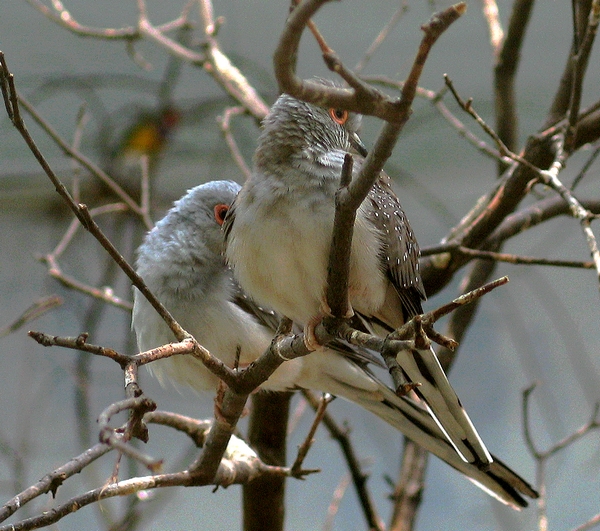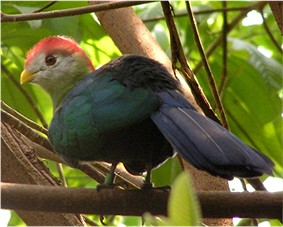Overview
 Like many bird fanciers, I was long drawn to the quiet beauty and calm demeanors of the various doves, but held back due to the large flight cages required by most, and the relative delicacy of the smaller species. That is, until I discovered the Diamond Dove. Barely larger than a canary, this tiny beauty is also quite hardy and long-lived, and is an ideal introduction to the group.
Like many bird fanciers, I was long drawn to the quiet beauty and calm demeanors of the various doves, but held back due to the large flight cages required by most, and the relative delicacy of the smaller species. That is, until I discovered the Diamond Dove. Barely larger than a canary, this tiny beauty is also quite hardy and long-lived, and is an ideal introduction to the group.
Physical Description
Diamond Doves tip the scales at a mere 1.5 ounces, and measure 7 to 7.5 inches in length. Their pleasing, subtly-colored plumage displays a surprisingly wide range of colors and shades. The head, breast and neck are clad in blue-gray, while the back is light brown. The tail is dark gray with black-tipped mid feathers and white-tipped outer feathers. The brownish gray upper wing is flecked with black-circled white spots, which lend the “diamond” to its name. The lower wing is chestnut in color and the abdomen is creamy white. The orange-red eye is encircled by a fire-red ring.
Range and Habitat
The enormous range covers much of northern and central Australia, with flocks moving to the southern and eastern coasts during particularly dry years. They are usually seen in pairs or small groups, but large flocks form during Australia’s winter.
Diamond Doves favor open habitats within flying distance of water – sparsely wooded areas, grasslands and desert fringes, but sometimes occur in parks and gardens as well.
Diet
Grass seeds of various types form the majority of the diet, with ants and other tiny insects being taken on occasion.
Reproduction
Males choose the nest site and court females by cooing with the beak held to the ground while spreading the tail feathers. They may also feed potential mates, and often puff their feathers and strut before females in the manner of the Rock Dove (our ubiquitous “city pigeon”). Paired birds exchange greeting calls and mutual light pecks about the head, and both contribute to the construction of the flimsy grass and stick nest.
A clutch consists of 2 eggs, laid 1 day apart. Both parents incubate the eggs – the female by night and the male by day. The eggs hatch in 12-15 days, and the young fledge in 12 days to 2 weeks (often longer in captivity).
In common with their relatives, Diamond Doves feed their young with “pigeon milk” – a thick liquid derived from the lining of the crop. Other than flamingoes, pigeons and doves are the only birds known to utilize such a food.
Miscellaneous
Diamond Doves are classified within the order Columbiformes and are members of the order’s sole surviving family, Columbidae – the pigeons and doves. The order also contains the infamous Dodo and the Solitaires, all of which are now extinct.
Approximately 320 species of pigeon-like birds are distributed on all continents except Antarctica. Two species, the Rock Dove and the Collared Dove, occur within the Arctic Circle. The genus to which the Diamond Dove belongs contains 4 other species, all of which are small, long-tailed birds of arid, open habitats in Australia and Indonesia.
At nearly 6 pounds in weight and 3 feet in length, New Guinea’s magnificent Victoria Crowned Pigeon, Goura victoria, is the world’s largest. I have kept and bred these massive blue birds at the Bronx Zoo, and found them to be both calm and very intelligent. If you have a chance to visit a zoo that houses Victoria Crowned Pigeons, please do – you will not soon forget the experience. The Common Ground Dove, Columbina passerina, just barely wins out over the Diamond Dove as the smallest. Measuring 6.7 inches long at weighing in at 1 ounce, it ranges from the southern USA to Brazil.
While a number of pigeons are specialized fruit-eaters, most feed upon seeds and grain. Seeds are not cracked but rather swallowed whole and ground up with the help of stones and other grit in the muscular gizzard. Unlike most birds, pigeons and doves drink by immersing their bills in water and sucking.
Next time we’ll take a look at keeping Diamond Doves as pets.
You can read more about the natural history of pigeons and doves at:
http://www.discoverlife.org/mp/20q?guide=Bird_species
Image referenced from Wikipedia, http://en.wikipedia.org/wiki/Image:Golabek_diamentowy.jpg. Author M. Betley, under the GNU Free Documentation License.
 That Bird Blog – Bird Care and History for Pet Birds
That Bird Blog – Bird Care and History for Pet Birds

 Toucans have long enchanted bird keepers and “regular people” alike. Having kept several large species in zoos, I can attest that their bright colors and clownish appearances are matched by their behavior. I have seen them toss grapes to one another for no apparent reason (mated pairs and youngsters were not involved) and engage in “beak dueling” bouts with no signs of aggression at all. All were unfailingly curious about me, and soon fed readily from my hand.
Toucans have long enchanted bird keepers and “regular people” alike. Having kept several large species in zoos, I can attest that their bright colors and clownish appearances are matched by their behavior. I have seen them toss grapes to one another for no apparent reason (mated pairs and youngsters were not involved) and engage in “beak dueling” bouts with no signs of aggression at all. All were unfailingly curious about me, and soon fed readily from my hand. considered by many ornithologists (biologists who study birds) to be the most intelligent of the world’s 9,000+ bird species. People have apparently held this view from the earliest of times, as the folktales and legends of many races are filled with tales attributing great powers and cunning ways to these impressive birds.
considered by many ornithologists (biologists who study birds) to be the most intelligent of the world’s 9,000+ bird species. People have apparently held this view from the earliest of times, as the folktales and legends of many races are filled with tales attributing great powers and cunning ways to these impressive birds. of the extinction of the USA’s only native breeding parrot, the Carolina Parakeet, Conuropsis carolinensis. The last known specimen of this species died in 1918, in the Cincinnati Zoo. However, a spectacular, pigeon-sized parrot once frequented the mountains of southern Arizona and New Mexico, gorging on pine cones before migrating south to breed.
of the extinction of the USA’s only native breeding parrot, the Carolina Parakeet, Conuropsis carolinensis. The last known specimen of this species died in 1918, in the Cincinnati Zoo. However, a spectacular, pigeon-sized parrot once frequented the mountains of southern Arizona and New Mexico, gorging on pine cones before migrating south to breed.
 t view of “imprinting”.
t view of “imprinting”.